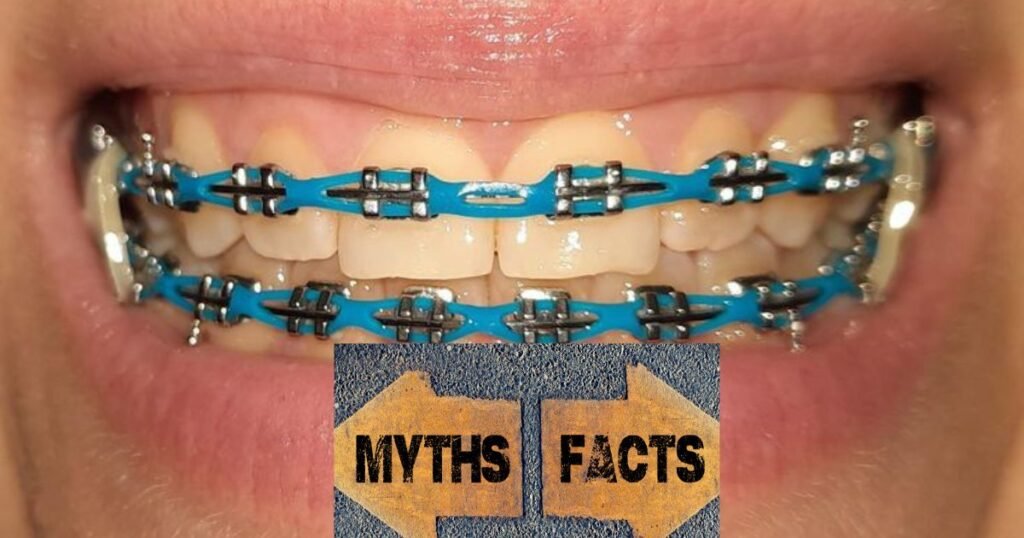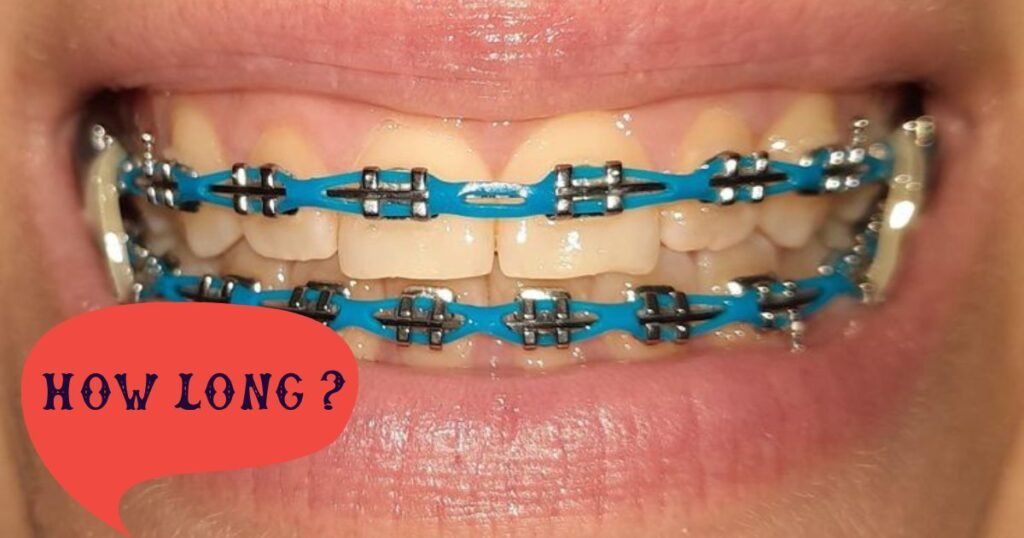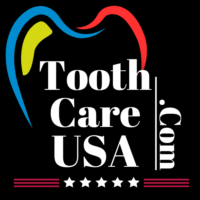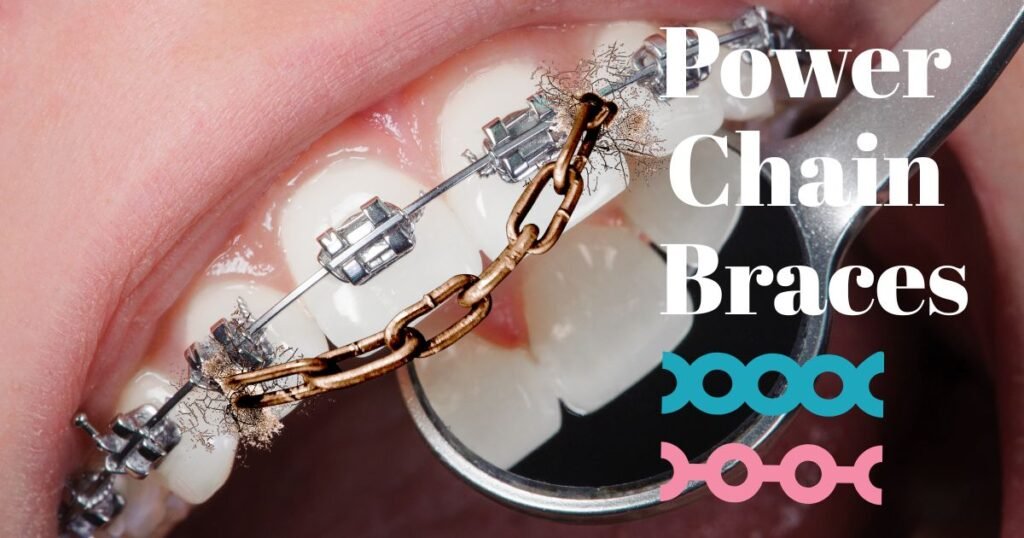Braces are a widely used orthodontic treatment designed to straighten teeth and improve bite alignment. Among the many components of braces, power chains play a crucial role in accelerating treatment by closing gaps and ensuring efficient tooth movement.
In this detailed guide, we will explore what power chain braces are, their types, benefits, risks, and how to for them.
What Are Power Chain Braces?
Power Chain Braces: Interactive Learning Tool
Power chain braces are elastic chains made of connected rubber loops placed over brackets to apply continuous pressure. They’re often used in orthodontics to:
- Close gaps between teeth
- Align teeth more efficiently
- Reduce treatment time
There are three common types of power chains used by orthodontists:
- Closed: No space between loops. Used for strong force.
- Short: Small space between loops. Moderate force.
- Long: Larger space between loops. Mild force over wider areas.
Orthodontists use power chains to:
- Close extraction spaces
- Fix midline deviations
- Adjust rotations and angulations of teeth
- Finish and polish alignment at the end of treatment
To care for braces with power chains, follow these tips:
- Brush after every meal using a soft brush
- Floss daily using a floss threader
- Avoid sticky or hard foods
- Use orthodontic wax if you feel irritation
- Visit your orthodontist as scheduled
Power chain braces are elastic chains made of connected rubber loops placed over brackets to apply continuous pressure. They’re often used in orthodontics to:
- Close gaps between teeth
- Align teeth more efficiently
- Reduce treatment time
There are three common types of power chains used by orthodontists:
- Closed: No space between loops. Used for strong force.
- Short: Small space between loops. Moderate force.
- Long: Larger space between loops. Mild force over wider areas.
Orthodontists use power chains to:
- Close extraction spaces
- Fix midline deviations
- Adjust rotations and angulations of teeth
- Finish and polish alignment at the end of treatment
To care for braces with power chains, follow these tips:
- Brush after every meal using a soft brush
- Floss daily using a floss threader
- Avoid sticky or hard foods
- Use orthodontic wax if you feel irritation
- Visit your orthodontist as scheduled
Power chains are a series of connected elastics that replace traditional rubber bands. They work by applying constant pressure on the teeth, helping them move too rapidly (and often within characteristic braces or rubber band brackets) to keep up with it.
Power chains are often used
- To close gaps left by extracted teeth,
- Align teeth faster than conventional braces
- They can also be used to correct bite trend problems by adjusting the position of the teeth
How Do Power Chain Braces Work?

Power chains function similarly to regular orthodontic elastics, but they provide more force over a larger area. They are attached to the brackets of the braces and create a pulling force that moves the teeth closer together.
Stages of Power Chain Braces Treatment:
- Initial Braces Phase: Brackets and wires straighten teeth.
- Adding Power Chains: Power chains (elastics) are placed by the orthodontist when teeth need extra pressure for movement.
- Tightening & Adjustments: Every 4-6 weeks, power chains are swapped out to maintain constant pressure.
- Final Retention Phase: Now that your teeth are in the correct position, retainers keep them there.
Types of Power Chain Braces
Power chains come in different strengths and configurations, depending on treatment needs. Here’s a comparison:
Types of Power Chains in Orthodontics
| Type | Description | Best Used For |
|---|---|---|
| Closed Power Chains | The rings are close to each other, and provide maximum force | For quickly closing small gaps and aligning teeth. |
| Short Power Chains | The rings have small spaces between them. | Moderate Gap with Minor Misalignment |
| Long Power Chains | The rings are separated by relatively large gaps – minimal force is needed to push them together. | The rings are close to each other and provide maximum force |
Orthodontists choose power chain types based on the patient’s specific treatment needs.
What are the Benefits of Power Chain Braces?
Power chains are used for various orthodontic adjustments. Here are some of their main advantages:
Faster Treatment Time
Power chains apply continuous pressure, helping to speed up tooth movement compared to regular elastics.
Effective in Closing Gaps
Whether due to extractions, natural gaps occurring from childhood dental development, or the problem of inadequate orthodontic treatment, that teeth have drifted apart – power chains can bring them together.
Enhances Overall Alignment
By distributing force over multiple teeth, power chains help improve bite correction and teeth positioning.
Versatile and Customizable
Power chains come in a variety of colors and sizes, allowing patients to personalize their braces while they undergo treatment.
What Discomfort & Pain Will Power Chain Braces Cause?

Like the regular brace setting, power chains can cause some general discomfort. It usually starts a couple of days after being placed or readjustment.
Common Side Effects of Power Chains:
- Soreness certainly (especially during the first 24-48 hours)
- Pressure on the teeth (similar to a braces tightening)
- Temporary difficulty in speech
Tip: Ordinary painkillers, cold foods, and adhesive paste all help numb Lthe ocal area and relieve pain.
How to Take Care of Power Chain Braces

Since power chains are made of elastic material, they are prone to staining much more than metal brackets of the kind that can be worn on bras. Proper maintenance is needed if you want to maintain their effectiveness and keep them looking good.
Brushing & Flossing Tips
- Use a soft-bristle toothbrush to avoid scratching the material on the chains.
- Floss with a string or a water flosser to clean between each pair of teeth in your mouth.
- Use toothpaste with fluoride in it to help prevent cavities from forming
Foods to Avoid
Certain foods can damage or stain power chains, including:
- Certain foods can harm or stain power chains, such as:
- Fat foods (caramel, gum) – can stick to the chain anyway
- Tea, coffee, colas, and various other foods such as curry, can stain teeth
Regular Orthodontic Visits
The elasticity of power chains changes over time, so they should be replaced every 4-6 weeks. Regular visits to your orthodontist will help keep the right pressure on your teeth for effective movement.’
Power Chain Braces: Common Myths and Misconceptions

Myth #1: Power Chain Braces Are Painful
Fact: They can indeed cause some discomfort, but the pain is temporary and not unbearable.
Myth #2: Power Chain Braces Can Only Be Used In Severe Cases
Fact: Power chain braces are appropriate for both small and large orthodontic problems alike.
Myth #3: You Can’t Eat With Power Chain Braces
Fact: It is possible to eat as usual with the braces, but certain foods should be avoided in order to prevent damage.
Power Chain Braces versus Rubber Bands: What’s the Difference?

Some people confuse power chains with ordinary orthodontic rubber bands, but they have different uses.
| Feature | Power Chains | Rubber Bands |
|---|---|---|
| Every 4-6 weeks by an orthodontist | Close gaps & move teeth | Correct bite alignment |
| Placement | Connected across multiple brackets | Placed between upper & lower teeth |
| Force | Continuous pressure | Intermittent pressure |
| Replacement | Placed between the upper & lower teeth | The orthodontic specialist should change them every 4-6 weeks |
These two components frequently function together, but the power chains are specifically designed to close gaps and move teeth effectively in a more advanced method.
How Long Must You Wear Power Chain Braces?

Depending on your orthodontic needs, the period during which power chains will be part of your treatment varies. Usually they are worn from 6 months to one year, but this depends on:
- The width of the gaps to be closed
- The degree of tooth misalignment
- How well you follow the orthodontist’s instructions
An interactive tool for calculating the power chain braces timeline
Power Chain Braces Treatment Timeline
Enter your treatment start date to get your estimated timeline for Power Chain Braces!
Are Power Chain Braces Right for You?

Power chains are useful in orthodontics, but they are not suitable for all cases. You may need power chains if:
- Gaps in teeth that should be closed.
- Your orthodontist just wants to move things quicker
- This means more force is needed to move a tooth
But all patients with braces require power chains. They may or may not be required by your orthodontist (depending on your treatment plan).
Conclusion
Power chains are an important part of orthodontic treatment as they enable the closing of the gaps, accelerate teeth alignment , and offer better results. Though they may be uncomfortable, they will speed up the treatment process and shorten the overall time you have to wear braces.
Proper oral hygiene, avoiding damaging foods, and showing up for your orthodontic visits will guarantee your power chain braces do the job for you and give you that beautiful, straight smile!
15 Detailed FAQs on Power Chain Braces
What does a power chain do for braces?
elastic loops that aid in pulling teeth together and aligning them more quickly. It delivers continual force to help teeth shift more predictably and efficiently, and it is commonly used after the first phase of treatment.
Explanation:
Closes Spaces Between Teeth – Aids in bringing teeth together after extractions or spaces.
Accelerates Tooth Movement – Delivers extra force for faster alignment.
Improves general alignment – works well for slightly crooked teeth.
Great for Later In Braces – Often added after brackets are individually aligned.
It’s available in a variety of colors and can be made to order to suit your design preferences.
May Be Uncomfortable for a Bit – Pressure can cause pain.
Needs Frequent Adjustments – Orthodontists replace them every couple of weeks.
Why did I get power chains so early?
If you noticed a power chain in the beginning, your orthodontist may have used them to fix the spaces, straigthen rotated teeth, or to accelerate your treatment some. Power chains may be needed at different times for different people as each case is individual.
Explanation:
Quick Gap Fix -To close space in teeth -Fit in gaps from missing teeth or extractions.
For Rotation of Teeth – Makes it easy to straighten twisted or misaligned teeth.
To Accelerate The Process – Treatment time is reduced by the application of continuous force.
Varies Based on Your Treatment Plan – Every patient is unique, making all orthodontic treatments unique.
Temporary or Long-Term Capable – Some people can wear these for a few weeks, while others can wear used for months.
May Result In Discomfort – Higher pressure can cause momentary aches.
Adjustment Needs – Power chains are changed often to maintain effectiveness.
What is the last step of braces?
The last stage of braces is comprised of taking off the brackets, buffing and polishing the teeth, and fitting a retainer to keep your teeth in place. This phase is necessary to maintain the correction of the bite.
Explanation:
Finishing Touches are Added – Ensures that the teeth are positioned correctly.
Braces are Taken Off – Brackets and wires are gently removed.
Teeth Get Shined Up -Any glue left over is wiped off for a clean surface to shine upon.
Retainers Are Provided – Aids in preventing teeth from shifting back.
Start of Retention Phase – Retainers are worn full-time to ensure a stable, lasting result.
Follow-Up Appointments Are Scheduled – Ensures stability of the alignment.
Smile Maintenance Becomes Key – Regular oral care prevents relapse.
How do you know if you need a power chain?
A power chain may be necessary if you have spaces, crooked teeth, or need to apply more force to straighten your teeth faster. Your orthodontist will make the decision based on the progress of your treatment.
If You Have Spaces Between Teeth, Power chains assist in closing spaces.
If your Teeth Require Additional Force to move, it provides constant force for translation.
If Your Treatment is in a Particular Phase – Commonly used in later stages.
If Teeth Are Rotating or Misaligned – Aids to perfect alignment.
If Braces Aren’t Enough – Works with brackets and wires.
If Prescribed by Your Orthodontist – Professional Diagnostic and Treatment Planning.
If You Experience Faster Movement with Power Chains – Some patients respond well.
What are the stages of braces?
The course of treatment involves three stages: The first stage addresses straightening the teeth, the second stage focuses on bite correction, and the third stage is the finish. Every stage is designed to wear on a specific type of tooth movement.
Explanation:
Phase 1: Alignment and Leveling – Aligns crooked teeth, addresses protrusions.
Phase 2: Bite Refinement – It will correct the bite with rubber bands or power chains.
Phase 3: Final Finishing & Detailing – Align before braces are removed.
Regular Adjustments Are Required – Wires and elastics are tightened over time.
Power Chains May Be Used in Later Stages – Helps close gaps efficiently.
Final Retention Phase Begins After Removal – Retainers prevent shifting.
Length of Treatment is Different – You may have braces from 12 months to 3 years.
What are the side effects of power chain braces?
Side effects of power chains would be mild pain, and teeth could generally be sore with a little more pressure on them. Gum irritation and mild difficulty with chewing may also occur in some patients.
Explanation:
Slight discomfort or pain – Because of increased pressure on the teeth to move.
Gum Irritation – The chain being elastic may irritate the gums.
Increased tension – More force than a regular brace adjustment.
Provisional Articulatory Codes – SA light lisp can also be found as an initiate.
Can’t Chew Hard Foods Easily – Sensitivity brings pressure to the teeth.
Elastic Stain Damage Risk – Staining power chains with dark foods and drinks.
Need for Frequent Adjustments – Power chains lose tension and require replacement.
Can power chains snap?
Yes, power chains can break because of too much stretching, hard food, and accidentally biting. When a power chain breaks, go see your orthodontist to have it replaced so that your treatment is not slowed down.
Explanation:
Rubber Material Can Degrade (even during use) – The chain wears down.
Hard or Sticky Foods Can Break It – Stay away from foods like nuts or caramel.
A Snapping Justification –Since you can bite by accident, you can snap by accident (sudden pressure can make a chain brittle).
Decrease the Breakage – Orthodontists replace them often.
A Chain That Snaps Can Be a Delay of Treatment — Broken chains can be a retarding influence.
If It Breaks – Call Your Orthodontist ASAP.
Stronger Power Chains are Available – Thicker chains can be used depending on the treatment.
Do rubber bands on braces hurt?
Rubber bands can be a little uncomfortable or sore when you first start wearing them, but after a few days, your teeth should feel normal. They exert more pressure to move teeth and adjust the bite.
Explanation:
Slight Discomfort is OK – Teeth are adapting to the additional burden.
Pain lasts for a Few Days- Subsides gradually as you flash them.
Assists Bite Alignment – Necessary for correcting jaw and closing gaps.
Frequent Use Lessens Pain – It does if you wear them regularly as directed by your orthodontist.
Pain Relievers May Help: Ibuprofen or acetaminophen may be used.
Gentler Foods Can Combat Pain –Eliminating firm foods eliminates unnecessary discomfort.
If You Have Severe Pain, Ask Your Orthodontist – May Require Adjustments.
How to eat with a power chain?
When you have a power chain on, eat soft foods and avoid all things sticky, hard, or crunchy to avoid (and spare yourself the pain of) discomfort and breakage. Eating more slowly or cutting food into smaller pieces may also help with chewing.
Explanation:
Consume Soft Foods – Mashed potatoes, yogurt, pasta, scrambled eggs.
Stay away from sticky foods – caramel, gum, toffees can tug the chain out.
Cut Food Down to Small Pieces - Cuts down on tension on the braces.
Use back teeth to chew – it’s less stress on your front teeth.
Hydrate Up — It rinses away food.
Restrict Sugary Foods – Discourages the accumulation of plaque around your braces.
Use Wax When Necessary – For less scratching on chain rubbing.
How long does braces pain last?
Braces hurt about 3-5 days after an adjustment, with mild pain lingering up to a week. Your mouth adjusts, and pain is no longer as salient.
Explanation:
Max Pain 24-48 Hr After – Getting Braces or Adjusted.
Relief in 3-5 Days – Most pain is eliminated within a week.
You May Be Sore for 1-2 Days, but it should still be somewhat manageable at this point.
Of Pain Relievers, Others Help: Ibuprofen or acetaminophen alleviates the ache.
Cold Foods Can Kill Pain – Ice cream, yogurt, and smoothies are good.
Wax Stops Bracket Rubbing – Lessens pain in cheeks.
Everything Can Hurt If You Do It Right – But it becomes less painful eventually.
How much are power chain braces?
As part of traditional orthodontia, power chain braces typically cost between $3,000 and $7,000, varying by geographic region and the severity of misalignment. Power chains do not, themselves, cost extra but are a part of the charges for braces.
Explanation:
Braces Cost: $3,000 – $7,000 (The cost of the braces depends on complexity and location.)
Power Chains Are Part Of The Fee – Don’t get charged extra.
Insurance May Help Pay Part of the Cost — Depending on the plan.
You Can Pay in Installments — Monthly payments can help your budget.
Treatment Duration Influences Cost – Longer treatments can be more expensive.
For a precise quote, consult an Orthodontist – Prices differ significantly.
Retainers Are Another Cost – After braces are off.

Dr. Niraj Ghanghoriya is a passionate dental surgeon with over 12 years of experience in clinical dentistry. He completed his BDS from the prestigious Sri Aurobindo Institute of Dentistry in 2012 and specializes in painless root canals, smile makeovers, and preventive oral care. Known for his patient-first approach and clear communication, Dr. Ghanghoriya aims to make dental knowledge accessible to everyone. When he’s not in the clinic, he enjoys writing informative dental blogs to help people take better care of their oral health.





